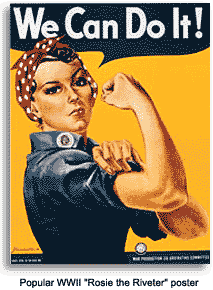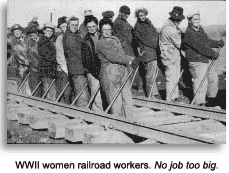It all started that shocking Sunday morning, December 7, 1941, as 183 Japanese warplanes attacked America’s Hickam Field, Pearl Harbor, in Hawaii. The devastating results were 2,433 deaths, the destruction of 18 U.S. warships and 188 airplanes. The surprise attack left the nation stunned as President Roosevelt called the United States to war.
With American men enlisting in the war effort, the work force quickly diminished. Who would "man" the assembly lines in the factories to produce the many needed items for the current war? Filling a gross shortage of manpower, through the factory gates flooded an army of woman power. Mothers, daughters, secretaries, wives and even schoolgirls picked up the factory duties the men had left behind.
Continual appeals were issued from government sources throughout the war, with articles and ads placed in magazines to get women's attention. Such titles as, “Women, you could hasten victory by working and save your man," abounded. The Magazine War Guide recommended that all published magazines participate in a "Women at work" cover promotion to emphasize not only defense and factory work, but all kinds of employment opportunities for women. One of the many slogans shouted, "The more women at work, the sooner we win."
 More than six million female workers helped to build planes, bombs, tanks and other weapons that would eventually win World War II. They stepped up to the plate without hesitation and gave up their domestic jobs to accomplish things that only men had done before them. They became streetcar drivers, operated heavy construction machinery, worked in lumber and steel mills, unloaded freight and much more. Proving that they could do the jobs known as "men’s work" created an entirely new image of women in American society, and set the stage for upcoming generations.
More than six million female workers helped to build planes, bombs, tanks and other weapons that would eventually win World War II. They stepped up to the plate without hesitation and gave up their domestic jobs to accomplish things that only men had done before them. They became streetcar drivers, operated heavy construction machinery, worked in lumber and steel mills, unloaded freight and much more. Proving that they could do the jobs known as "men’s work" created an entirely new image of women in American society, and set the stage for upcoming generations.
Every day the women, both young and old, would punch into work at the shipyards, factories and munitions plants across America. During the war the women increased the workforce by 50 percent. Racial barriers were broken as various minority members went to work. Coming from all walks of life, there were those already working who switched to higher-paying defense jobs, those who had lost their jobs due to the Depression, and then of course there were the women who worked at home.
With that many women working in war-related jobs, the phenomenon changed America. Child care centers emerged all over the country. Most of the centers were built adjacent to the plants for the families' convenience. The women who used to stay home with the children now were not only able to work for their country, but were also given the opportunity to earn their way in the world. They were hardworking individuals and that fact shed a new light on America as a whole.
By 1942 women were being urged to take advantage of any technical training to better prepare themselves to replace the men now in uniform. They would perform not only a patriotic duty, but help themselves financially. In some areas, women took the lead to accomplish certain tasks to support the nation’s war effort. There was a huge new opportunity to work for the American Red Cross. Women not only learned basic first aid techniques, but also were on call as volunteers at the local USO, which was considered to be an honor.
Eleanor Roosevelt toured the factories and came away in awe of the new work force. She heard countless success stories and was quoted as saying, "I hardly saw a man who did not speak to me about the need for women in production." Many women reported that they felt patriotic and wanted to support their country, and that the money came second. It gave them endless pride to know they were doing their part to help win the war. They quickly become known as the "production soldiers" in the defense industries.
 Rosie the Riveter’s first mention was in a song written by Redd Evans and John Jacob Loeb in 1942. The song caught on across America as the lyrics told the true story. One line of the song goes, "that little frail girl can do/more than a man can do." Some were actually better at certain tasks than men — while women war workers were paid only 60 percent of male wages. Reportedly the women who were at 60 percent were over 35 years of age and approximately one third had children under 14.
Rosie the Riveter’s first mention was in a song written by Redd Evans and John Jacob Loeb in 1942. The song caught on across America as the lyrics told the true story. One line of the song goes, "that little frail girl can do/more than a man can do." Some were actually better at certain tasks than men — while women war workers were paid only 60 percent of male wages. Reportedly the women who were at 60 percent were over 35 years of age and approximately one third had children under 14.
A real-life Rosie brought the character to life. Her name was Rose Will Monroe. The Hollywood star Walter Pidgeon was touring the Ford Motor Company aircraft assembly plant when he met Monroe. On his recommendation, she starred as herself in a government film promoting the war.
The famous illustrator Norman Rockwell then created a "Rosie" image to appear on the cover of the Saturday Evening Post, May 29, 1943 — the Memorial Day issue. The picture depicted a large woman wearing overalls, goggles and displaying various pins of honor on her lapel. She wore a leather arm band and flexed her bicep with a rolled-up sleeve, while sitting with a large riveting tool in her lap. In one hand was a sandwich and she was wearing lipstick. Printed boldly beside her were the words, “We can do it." Emphasizing her patriotism with the American flag as the background and her feet planted firmly on Hitler’s Mein Kampf, the image on that issue was a huge success. America loved Rosie! While Rosie the Riveter became an icon, the Post circulation nearly doubled.
Shortly thereafter, stories appeared in the press about yet another real-life "Rosie." Her name was Rose Hicker, employed at the Eastern Aircraft Company in Tarrytown, New York. She and her work partner had driven a record number of rivets into a wing of a Grumman “Avenger” Bomber. And so the story goes as the Rosie evolved across the country. Both real and legendary, the “Rosies” were depicted in the press, celebrated in song, and produced in Broadway plays and movies.
As the new moniker spread, some feminine touches were added to the workplace that helped women produce even more efficiently. As the work environment improved, they held sing-alongs while working and during meal preparation. Some of the plant workers started wearing a pink uniform, the same color as World War II officers.
By 1944, 16 percent of all working women held jobs in war industries. While an estimated 18 million women worked during the war, there was growing concern among them that when the war was over, it would never be the same again. That new venture for American women, while profitable in more ways than one, would soon come to an end. Some faced harassment for attempting to stay in industry, and the government insisted that they were just a substitute until the war was over, but the women never faltered. They had changed industry and left permanent effects.
When the war ended with the Allies victorious, the need for munitions workers abruptly ceased. Women were now forced to leave their jobs to seek others. But the number of working women never again fell to pre-war levels, and their significant contribution is still recognized today. Rosie the Riveter lives on in movies, books and songs.
Honoring the Rosies
 The Rosie the Riveter World War II Home Front National Historical Park is located in Richmond, California. In the park, a Rosie the Riveter Memorial honoring American women’s labor during the war was dedicated on October 14, 2000. Two hundred real-life Rosies attended the dedication ceremony. The memorial evokes every aspect of the mass assembly techniques as well as the memories of the American women who worked tirelessly during that mighty conflict.
The Rosie the Riveter World War II Home Front National Historical Park is located in Richmond, California. In the park, a Rosie the Riveter Memorial honoring American women’s labor during the war was dedicated on October 14, 2000. Two hundred real-life Rosies attended the dedication ceremony. The memorial evokes every aspect of the mass assembly techniques as well as the memories of the American women who worked tirelessly during that mighty conflict.